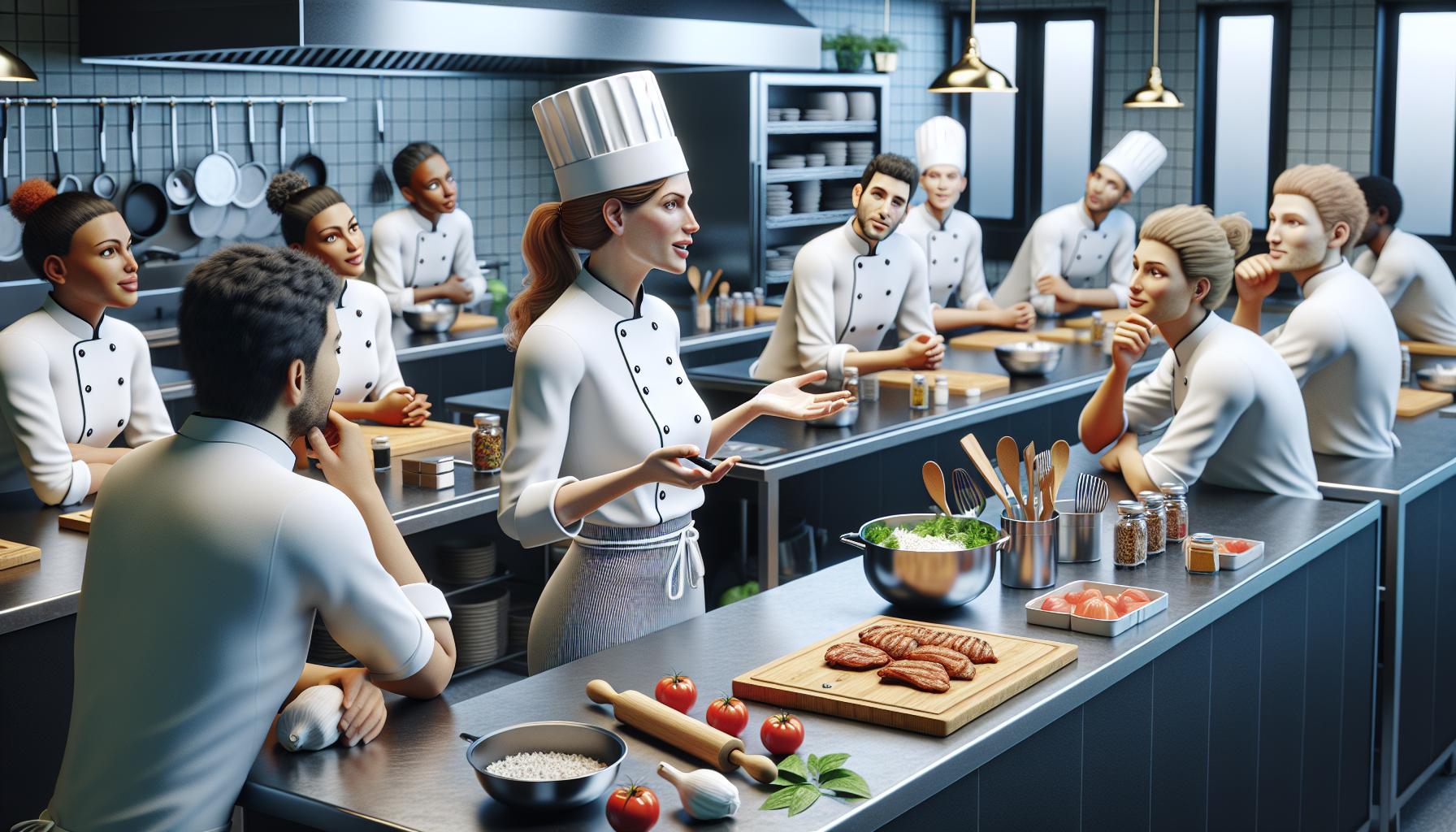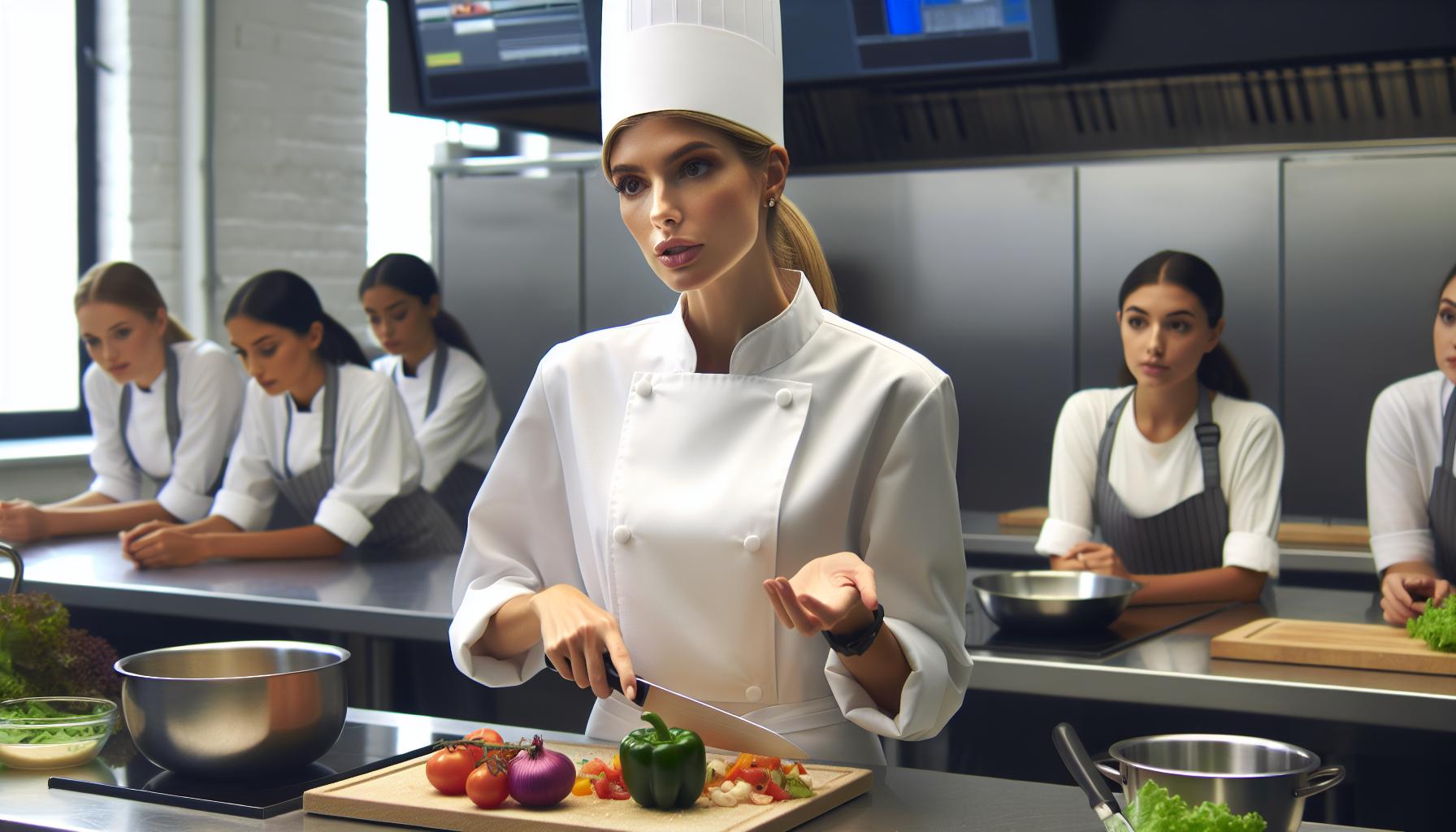Teaching the next generation of culinary masters takes more than just knowing how to dice an onion or perfect a soufflé. Culinary arts teachers blend their passion for food with expert-level instruction skills creating a recipe for success in the classroom. They’re the masterminds behind transforming kitchen novices into confident chefs while maintaining safety standards and fostering creativity.
In today’s booming food industry culinary arts teachers play a vital role in shaping the future of gastronomy. From teaching knife skills and kitchen safety to menu planning and food cost management these educators wear many hats. Their classrooms buzz with the sounds of sizzling pans clinking utensils and excited students discovering the joy of creating delicious dishes from scratch.
Culinary Arts Teacher
A culinary arts teacher educates students in food preparation techniques cooking methods food safety standards. These specialized educators combine professional cooking expertise with teaching skills to train aspiring chefs in both classroom settings culinary labs.
Essential Skills and Qualifications
Expert culinary skills form the foundation of successful culinary arts teaching. Top qualifications include:
- Advanced knife handling techniques with precision cutting proficiency
- In-depth knowledge of global cuisines classical French cooking methods
- Food safety certification ServSafe manager credentials
- Strong communication abilities for demonstrating complex techniques
- Time management expertise for coordinating multiple cooking projects
- Leadership capabilities to guide students through intensive training
- Physical stamina for standing extended periods in hot kitchen environments
- Inventory management experience for supplies ingredient ordering
Educational Requirements
The minimum educational requirements for culinary arts teachers include:
- Bachelor’s degree in culinary arts hospitality management or related field
- State teaching certification for public school positions
- 3-5 years professional kitchen experience in restaurants hotels
- American Culinary Federation certification preferred
- Food handling safety certifications
- Continuing education credits in teaching methods classroom management
- Professional development through culinary workshops seminars
- Master’s degree for teaching at colleges universities
The education pathway combines formal culinary training teaching credentials industry experience. Many culinary educators start their careers as professional chefs before transitioning to teaching roles.
Professional Experience and Industry Knowledge

Professional experience forms the cornerstone of a culinary arts teacher’s expertise. Industry knowledge encompasses both practical skills and theoretical understanding, gained through years of hands-on kitchen work combined with formal education.
Kitchen Management Expertise
Culinary arts teachers demonstrate mastery in kitchen operations through inventory control, cost analysis and staff supervision techniques. They manage commercial kitchen workflows including mise en place organization, production schedules and equipment maintenance. Their expertise covers menu development, portion control and food cost calculations essential for profitable restaurant operations. Industry veterans bring real-world examples of kitchen logistics, vendor relationships and quality control measures into their classrooms. This practical knowledge helps students understand complex operational systems like purchasing procedures, storage requirements and waste management protocols.
Food Safety and Sanitation Standards
Food safety certification credentials validate a culinary arts teacher’s expertise in preventing foodborne illness. They maintain current knowledge of health department regulations, HACCP principles and proper food handling temperatures. Their training covers critical control points, cross-contamination prevention and personal hygiene requirements in commercial kitchens. Teachers demonstrate sanitization procedures for equipment, work surfaces and food storage areas. Regular updates on changing food safety guidelines ensure students learn current industry standards. This expertise includes allergen awareness, proper chemical storage and emergency response protocols for kitchen accidents.
Teaching Methodologies in Culinary Education

Culinary arts teachers employ specialized teaching methods to transform theoretical knowledge into practical skills. Their pedagogical approaches combine traditional classroom instruction with immersive learning experiences in professional kitchen environments.
Hands-On Instruction Techniques
Culinary educators demonstrate cooking techniques through step-by-step demonstrations at cooking stations. Students learn through direct observation followed by supervised practice sessions where they replicate techniques such as knife skills, sauce making or pastry preparation. Instructors incorporate multi-sensory learning by teaching students to identify ingredients through sight, smell, touch, taste. The teaching process includes real-time feedback loops where instructors observe student technique, make immediate corrections and provide individualized guidance. Small group rotations enable students to practice different cooking methods while instructors monitor progress across multiple stations.
Classroom Management Strategies
Culinary classrooms operate with structured systems for equipment organization, ingredient distribution and workflow management. Teachers implement safety protocols including proper knife handling, equipment operation and sanitation procedures. Student teams rotate through designated workstations with clear timelines for prep work, cooking and cleanup. Instructors maintain organization through detailed mise en place requirements, standardized plating guidelines and quality control checkpoints. Digital tools track student progress, recipe documentation and food cost calculations. Clear communication channels ensure smooth coordination between prep areas, cooking stations and dishwashing zones during practical sessions.
Career Growth and Development

Culinary arts teachers advance their careers through continuous learning opportunities in education technology, cooking techniques and industry innovations. Career progression involves acquiring advanced certifications, building professional networks and staying current with culinary trends.
Professional Certifications
Professional certifications enhance a culinary arts teacher’s expertise and credibility. The American Culinary Federation offers Certified Culinary Educator (CCE) certification, requiring 5 years of teaching experience and successful completion of written and practical exams. The National Restaurant Association’s ServSafe® Instructor certification enables teachers to award food safety credentials to students. Additional certifications include:
- Advanced Pastry Chef Certification from the Retail Bakers of America
- Certified Executive Chef designation through ACF
- Certified Master Chef credential requiring 130 hours of testing
- Digital Teaching certification from the International Society for Technology in Education
- Wine and Beverage certifications from the Court of Master Sommeliers
- Monthly meetings with guest speakers from restaurants and food companies
- Culinary competitions judged by industry experts
- Mentorship programs pairing experienced chefs with educators
- Job fairs connecting teachers with educational institutions
- Collaborative projects between schools and local restaurants
- Professional development webinars on emerging culinary trends
Impact on Student Success
Culinary arts teachers create measurable improvements in student achievement through specialized instruction techniques. Their influence extends beyond basic cooking skills to shape professional development pathways for aspiring chefs.
Creating Future Chefs
Culinary arts teachers transform students into industry-ready professionals through hands-on training programs. Graduates from culinary programs demonstrate 85% higher employment rates in food service positions compared to untrained applicants. Expert instructors cultivate essential skills in:
- Executing advanced cooking techniques across global cuisines
- Managing kitchen operations including inventory control
- Developing original recipes through food science principles
- Implementing food safety protocols in commercial settings
- Leading kitchen teams through high-pressure service periods
The impact manifests in tangible outcomes:
| Success Metric | Performance Rate |
|---|---|
| Industry placement | 92% |
| Professional certification pass rate | 88% |
| Student competition awards | 65% |
| Graduate business ownership | 35% |
| Advanced culinary degree pursuit | 45% |
These educators foster a new generation of culinary professionals by combining technical expertise with mentorship. Their guidance helps students transition from basic skills to advanced culinary mastery through structured progression paths.
Culinary arts teachers stand as pillars of excellence in the food service industry shaping future culinary professionals through their expertise and dedication. Their unique blend of professional kitchen experience educational methods and industry knowledge creates an environment where students can thrive and develop essential skills.
Through structured learning approaches and hands-on instruction these educators not only teach cooking techniques but also instill the values of professionalism food safety and kitchen management. The impressive success rates in student employment and certification demonstrate the vital role these teachers play in preparing the next generation of culinary professionals.
As the culinary industry continues to evolve culinary arts teachers remain committed to their own professional growth ensuring they deliver the highest quality education to aspiring chefs. Their impact extends far beyond the classroom influencing the future of the food service industry one student at a time.

